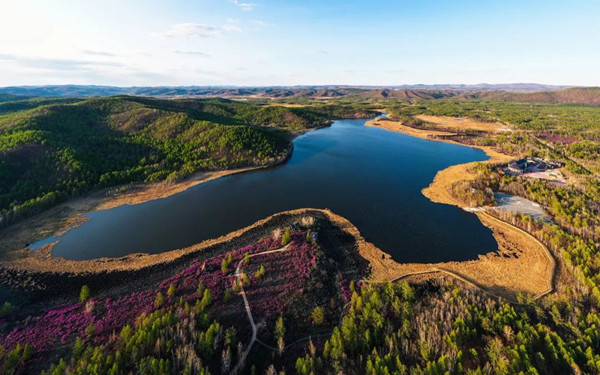Dubbed "the Green Great Wall in North China" and "a key ecological protective zone in North China", the Greater Hinggan Mountains forest area in the Inner Mongolia Autonomous Region is a compound ecological resource covering 106,700 square kilometers. It plays an important role as the ecological backbone of North China.
Through the past decades, China Inner Mongolia Forestry Industry Ltd. Co. (CIMFILC) has been making efforts to foster green development and construction in the region.
Development and construction of the Greater Hinggan Mountains forest area
A national forestry meeting was held on Feb 28, 1950, to approve development of the Greater Hinggan Mountains forest area. In the early summer of 1952, the government of Inner Mongolia Autonomous Region approved establishment of the predecessor of CIMFILC.
In the early stage of its development, the area was built into a key national wood material production base. Before logging was banned, more than 200 million cubic meters of commercial timber and minor forest products were produced at the Greater Hinggan Mountains forest area and over 20 billion yuan ($2.91 billion) of tax had been paid, which strongly supported the country's economic growth.

A bird's-eye view of the Greater Hinggan Mountains forest area in Inner Mongolia Autonomous Region [Photo by Liu Zhaoming]
Sustainable development promoted in the Greater Hinggan Mountains forest area
Logging is not immoderate plunder. The idea of sustainable logging and forest construction was raised by the country in the early days of the region's development.
In 1958, the idea of logging while planting was proposed and the authority intended to realize the goal of planting more trees than those cut. The idea was followed until the logging ban was released, which laid a foundation for solid ecological construction of the region.
China launched a natural forest resource protection program in 1998, when the main business at the forest area started to transform from timber production to ecologically protective construction. The timber output went down gradually from 4.25 million cubic meters to 1.1 million cubic meters annually.
On the other hand, tree planting never stopped despite of the reduction in logging.
On April 1, 2015, commercial logging of natural forest in the region was completely banned, ending 63 years of logging and beginning a new march of ecological construction.
Statistics show that in the 70-year development of the region, the artificial afforestation area reached over 20 million mu (about 133 hectares) and the net increases in forest coverage and forest stock volume grew by 1 million hectares and 300 million cubic meters as a result of the natural forest resource protection program. Forest coverage went up by 9.25 percentage points during the period.

A female tree-planting team plants trees in the Greater Hinggan Mountains forest area. The team planted about 70 million seedlings within 30 years. [Photo/sasac.gov.cn]
Green development promotes economic growth
Green GDP has been regarded as a direction of green development in the Greater Hinggan Mountains forest area and a base to realize high-quality growth.
Based on the region's green resource advantage, CIMFILC launched several subsidiaries focusing on fields like carbon sinks, tourism and undergrowth vegetation products, intending to push forward development of related industries and create local green brands.

A view of the carbon sink forest at the Suotuhan Tree Farm managed by a subsidiary of CIMFILC [Photo/sasac.gov.cn]
Trade in forest carbon sinks is a crucial complementary mechanism of carbon emission trading and a market-oriented channel to carry out compensation for ecological conservation.
As China's largest key national forest area, the Greater Hinggan Mountains are a main force to support the country's "dual carbon" goals of peaking carbon dioxide emissions by 2030 and achieving carbon neutrality by 2060.
CIMFILC started to launch forest carbon sink project pilots in 2014 and in 2017 completed its first carbon sink trade valued at 400,000 yuan, a milestone of the transformation from ecological to economic benefit.
In early 2021, the company registered a new subsidiary focusing on carbon sink technology. So far, CIMFILC has completed 34 trades of carbon sink products valued at 34 million yuan.
China intends to increase forest stock volume by six billion cubic meters by 2030 over that of 2005, and the Greater Hinggan Mountains aims to reach 600 million cubic meters, accounting for one-tenth of that total.
In addition to developing the carbon sink industry, CIMFILC also has an eye on tourism.
Blooming azaleas in spring, flourishing trees in summer, colorful sightseeing in autumn and a splendid ice and snow world in winter — the different views of the Greater Hinggan Mountains forest area are invaluable assets and treasures for attracting visitors from home and abroad.

A view of the Darbin Lake National Forest Park with azaleas blossoming in the Greater Hinggan Mountains forest area [Photo/sasac.gov.cn]
CIMFILC has made clear plans to develop the local tourism industry. It has built one national 5A-level scenic spot, three 4A-level spots and several 3A-level spots and developed a series of reproducible stimulants for that purpose.
The consequent rapid development of tourism has increased popularity of the area's undergrowth vegetation products.
For the past decades, the company also made great efforts to develop the undergrowth vegetation economy based on the forest's natural resource advantages. It has built national green forest product bases and developed undergrowth vegetation industries related to fruits, drugs, mushrooms and vegetables, as well as reindeer breeding. Economically harvestable Hippophae and hazel have also been grown in the forest area.

The photo shows mushrooms grown by CIMFILC's subsidiary. The company grows more than 5 million bags of such mushrooms annually and this year, the output has exceeded six million, increasing the annual income of each household that grows the mushrooms by an average of 50,000 to 60,000 yuan. [Photo/sasac.gov.cn]
(Executive editor: Wang Ruoting)